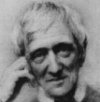
Principle 5. Shades of human speechSacred Scripture knows all the shades of human affirmation. It only wants to assert as much as implied in human language.
It is this aspect of inspired writing that we should explore. |
Interpreting Scripture CorrectlyLESSON FIVE
|
The range of human affirmationDid you ever reflect on the infinite variety of affirmation that is at our disposal? We know that astronauts have landed on the moon. A discussion has begun on the desirability of sending a manned spacecraft to Mars. Will Russia take part? We may read remarks as the following: "Russians too will surely land on Mars!" It should be noted how such statements contain much more than simple affirmations or negations. They express a whole range of assertion: from absolute certainty down to probability or opinion. What happens if such statements are inspired? Could God inspire a probable statement, a doubtful remark or a mere opinion? The answer is : yes. And : God affirms not more nor less than what is affirmed by the human authors. In other words: if the human author asserts a doubtful statement, God's inspiration will not change the nature of the assertion. It will remain an inspired, yet doubtful remark! It is Saint Paul who provides us with a classical proof. Speaking with great indignation he says to the Corinthians:
[A.] "I am thankful that I baptized none of you except Crispus and Gaius! Lest anyone should say that you were baptized in my name." [B.] "I did baptize also the household of Stephanas." [C.] "Beyond that I do not know whether I baptized anyone else." We can follow Paul's thought. With some vehemence he states that he baptized no one except Crispus and Gaius (statement A). It then comes to his mind that he also baptized Stephanas' family (statement B). He ends up expressing his mind as in doubt: "I do not know whether I baptized anyone else" (statement C). It is a really human way of speaking. All three statements have to be read together, since the second and third correct the first one. Moreover, the sum total of the three statements remains a doubt. Does the fact of the text's inspiration change this human aspect! Does it make a dogma of each of these statements? Does it turn the doubt into a certainty? Of course it doesn't! Paul's basic affirmation is that it does not matter how many people he baptized, because the important thing is that they were all baptized in Jesus's name: this basic affirmation with all nuances is equally asserted by the Holy Spirit! Moreover, the example also illustrates that - just like we ourselves - the biblical authors may forget certain facts, overstate matters, express doubtful questions as if they are certain. Do we claim that everything we say is a 100% definite and correct? Are our every-day statements equivalent to sworn testimonies we give in court? The same measure of inaccuracy and certainty must be granted to biblical authors. |
|
Kohelet's doubtsThe author of Kohelet wrestles with a real problem: What is the purpose of life? What gain has a human being from all the toil and strain with which he/she toils beneath the sun? (Kohelet 2,22). It is a theme repeated over and over again by the author. Life stands before him as one great question mark: "Who knows what is good for human beings while they live the few days of their useless life which passes like a shadow?" (Kohelet 6,12).
The author does not succeed in finding a complete answer to his question. He affirms faith in God who will punish the wicked and reward the good (Kohelet 8,12; 12,1; etc), but his problem as to the ultimate purpose of this hard life of human beings remains! What to make of this inspired book? The answer is simple. God inspired a philosopher, a thinker, not to make statements but to raise questions. It was his task to make his contemporaries think, to make them realize that indeed suffering and death are — humanly speaking — insoluble riddles. It was only the revelation and redemption brought by Jesus Christ that would provide God's solution to these problems! Here again inspiration followed the nature of the book inspired; the author meant to put his finger on a problem without providing a full solution. God inspired him to do precisely that much and nothing more. |
The book of Kohelet was written by a Palestinian Jew during the third century BC. The Greek version known to us now was translated in the hellenistic city of Alexandria. |
A truth in every sentence?Let us have a second look at the way we speak and write. Some people seem to think that every sentence automatically carries an affirmation, but nothing is less true. Questions by themselves neither affirm nor deny a truth. Commands, wishes and requests reveal the will of the speaker, but do not affirm anything. Metaphors often sustain a different affirmation from that which the face-value of the words would suggest. In each case we have to determine what the author wants to assert: this much and no more is asserted by God. To illustrate this point let us turn to the gospels which are probably more familiar to us.
In Scripture God employs human instruments. God's message follows the nature of their speech. And in human speech much is said without any assertion. Many statements vary in the degree of certainty expressed. Many metaphors and modes of speech carry an affirmation that differs considerably from the external sound of the words. In all these cases divine inspiration remains faithful to its instrument. God asserts and affirms what the human author asserts and affirms: nothing more and nothing less. In this sense God truly speaks through the human person. Human language is much richer and more versatile than being a catalogue of dogmas. |
|
Case study: the parable of Lazarus & hell fireBegin by looking at this video (click on start arrow):
In the parable, Jesus clearly implies that people in hell are tormented by fire:
Until modern times most Christians believed that the fire in hell is real, exactly like fire on earth! This belief was confirmed as correct by the Sacred Penitentiary in Rome, one of the papal offices, on 30 June 1890. But did Jesus really want to teach that hell fire is real fire? Or was he just referring to hell fire casually, making it part of his story? To understand the ramifications of human language , please examine this case study very carefully: The parable of Lazarus and hell fire. |
|
Exercise: Paul on homosexualityIn his letter to the Romans, Paul expresses his disgust with practices found among pagan society of his time:
Romans 1,24-27 Read the whole context of Romans 1,18-32 and try to answer the following questions:
|
|
|
God employs human instruments. His message follows the nature of their speech, And in human speech much is said without any assertion. Many statements vary in the degree of certainty expressed. Many metaphors and modes of speech carry an affirmation that differs considerably from the external sound of the words. In all these cases divine inspiration remains faithful to its instrument. God asserts and affirms what the human author asserts and affirms: nothing more and nothing less. In this sense God truly speaks through the human person. As Jeremiah testifies :
|
|
Go to the next lesson: We have to distinguish substantial statements by the author from rationalizations. |
course overview |
CreditsThe texts in our course Interpreting Scripture Correctly were written by John Wijngaards in 2009. Part of the contents is based on his earlier publications, in particular:
Illustrations in the video clip by Jackie Clackson. |
 |
 |
 |
 |
 |
|
|---|---|---|---|---|---|
| Facts |
 |
 |
 |
 |
|||